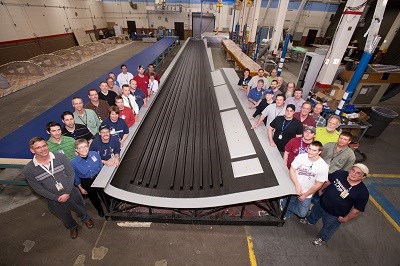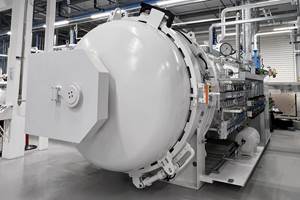CW opens up on out of autoclave, in February
You may not know that CW has prepared a Supplement to the upcoming February 2016 issue that examines out of autoclave processing in detail. It asks the question: Can OOA options be matured sufficiently to yield parts with <1% void content, outside of the autoclave?

This demonstration wingskin is a 21m-long hat-stiffened, monolithic part built by The Boeing Co.’s (Chicago, IL, US) facility in St. Louis, MO, US. Materials used in the wingskin were Cytec’s trademarked CYCOM 5320 unidirectional and fabric out of autoclave (OOA) prepregs. Photo source: DARPA
The quest for prepreg materials capable of being processed without an autoclave, but able to produce autoclaved part performance properties, began in the mid-1990s. It was driven, in part, by the US Air Force and the US National Aeronautical and Space Admin. (NASA), which envisioned composite launch vehicle components far too large for any autoclave.
You may not know that CW has prepared a Supplement to the upcoming February 2016 issue that examines out of autoclave processing in detail. It asks the question: Can OOA options be matured sufficiently to yield parts with <1% void content, outside of the autoclave? The answer, based on detailed applications where OOA processing is in place, is yes, but there is a larger question: Can OOA processes match this <1% void parameter and demonstrate enough overall savings in capital expense and time to justify the process development/recertification efforts that a move to OOA will require?
I learned a lot while researching the efforts being made by many to improve current OOA processing methods. One illuminating development is work done by Cytec Solvay Group (Tulsa OK, US and Woodland Park, NJ, US) on out of autoclave (OOA) prepregs, often called VBO prepregs.
As most of you already know, VBO prepregs allow lower-cost tooling that doesn’t have to withstand autoclave pressure, and lower processing costs (parts are vacuum bagged and oven cured). Coefficient of thermal expansion issues between part and tooling are fewer, because the cure temperature can be lower. But thorny technical issues can include high void content, surface pitting on the tool side surface, insufficient out time for fabricating large parts, and compatibility issues with ancillary materials including adhesives.
When early investigators attempted VBO processing with traditional prepregs, they found that, without the autoclave’s pressure, air became trapped in the layup causing voids. OOA-optimized prepregs for hand layup, sometimes called semi-pregs, have since been designed with lower resin impregnation levels, which leaves dry fiber paths for evacuation of air and any moisture that is absorbed by the epoxy resin when exposed to air during layup. To ensure that the air can be pulled out, in the plane of the laminate, an “edge breathing” vacuum bagging technique is employed, which keeps at least one laminate edge in contact with breather material. Because semi-preg is not fully saturated with resin and contains open air evacuation paths, it is bulkier than conventional prepreg, and care must be taken to mitigate bridging and wrinkling especially in shaped parts with corners.
Most important, air evacuation must occur before resin crosslinking and viscosity increase to the point that the air pathways become blocked. Many fabricators, therefore, employ long vacuum “dwells” at low-to-moderate temperatures — 16 hours or more — to ensure full evacuation of air before the oven temperature is elevated to cure (crosslink) temperature, a procedure now shown to be unnecessary. “The need for long dwells is a common misconception, since much published literature on VBO prepregs has been associated with development programs on low-cost tooling where cure time wasn’t an issue,” says Chris Ridgard, associate technical fellow at Cytec Solvay Group. “We’ve developed a method called super-ambient dwell that can significantly shorten cure cycles by 50%, for production settings.”
Super-ambient dwell employs a high level of vacuum, at least 60 cm Hg (using a dedicated vacuum pump), and a resin temperature typically between 50° and 60°C, which together, says Ridgard, exceeds the boiling point of water — thus driving off the entrapped moisture — without causing the resin to flow sufficiently that the air evacuation channels are closed off. He cites monolithic (uncored) carbon/epoxy panels, one made with super-ambient dwell of 4 hours and the other in a 16-hour room temperature dwell, which ultimately showed equal cured porosity (around 2%). “Cure times comparable to those of autoclaved prepregs have now been demonstrated,” he adds. New, second and third generation OOA prepregs have now also resolved the issue of out time, which currently is typically 21 days at room temperature, or longer.
In the case of cored parts made with OOA prepreg, care must be taken to prevent air trapped within core cells from causing laminate porosity; venting the core through the use of a breather ply is necessary. And because autoclave pressure is lacking, adhesive foaming during cure can affect face skin/core bond quality due to the high vacuum levels, which act to lower the boiling point of water in the adhesive. Ridgard says a number of core adhesives compatible with OOA cure conditions have been developed.
It turns out that in addition to epoxy resin, OOA prepregs have been developed for bismaleimide, polyimide and benzoxazine resins for higher temperature applications. While numerous production parts are likely being made using VBO methods, details aren’t available for many, but our Supplement does describe some notable examples. The VBO demonstrator wingskin shown in the photo is a 21m-long hat-stiffened, monolithic part built by The Boeing Co.’s (Chicago, IL, US) facility in St. Louis, MO, US. Materials used in the wingskin were Cytec’s trademarked CYCOM 5320 unidirectional and fabric OOA prepregs.
So watch for the Supplement; I’m sure you’ll find much of interest there.
Related Content
Busch expands autoclave solutions
Busch announces its ability to address all autoclave, oven and associated composites manufacturing requirements following the acquisition of Vacuum Furnace Engineering.
Read MorePlant tour: Airbus, Illescas, Spain
Airbus’ Illescas facility, featuring highly automated composites processes for the A350 lower wing cover and one-piece Section 19 fuselage barrels, works toward production ramp-ups and next-generation aircraft.
Read MoreComposites manufacturing for general aviation aircraft
General aviation, certified and experimental, has increasingly embraced composites over the decades, a path further driven by leveraged innovation in materials and processes and the evolving AAM market.
Read MoreIndustrial composite autoclaves feature advanced control, turnkey options
CAMX 2024: Designed and built with safety and durability in mind, Akarmark delivers complete curing autoclave systems for a variety of applications.
Read MoreRead Next
“Structured air” TPS safeguards composite structures
Powered by an 85% air/15% pure polyimide aerogel, Blueshift’s novel material system protects structures during transient thermal events from -200°C to beyond 2400°C for rockets, battery boxes and more.
Read MorePlant tour: Daher Shap’in TechCenter and composites production plant, Saint-Aignan-de-Grandlieu, France
Co-located R&D and production advance OOA thermosets, thermoplastics, welding, recycling and digital technologies for faster processing and certification of lighter, more sustainable composites.
Read MoreVIDEO: High-volume processing for fiberglass components
Cannon Ergos, a company specializing in high-ton presses and equipment for composites fabrication and plastics processing, displayed automotive and industrial components at CAMX 2024.
Read More













.jpg;maxWidth=300;quality=90)








